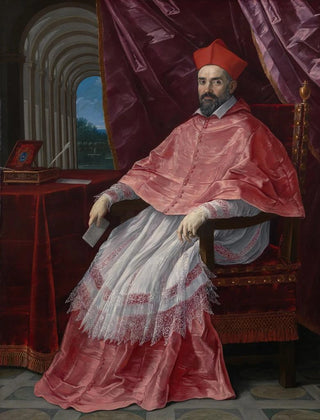Art print | Cardinal Roberto Ubaldini 1581-1635 Papal Legate in Bologna - Guido Reni


View from behind

Frame (optional)
Reproduction Cardinal Roberto Ubaldini 1581-1635 Légat pontifical à Bologne - Guido Reni – Introduction captivante
The art print "Cardinal Roberto Ubaldini 1581-1635 Légat pontifical à Bologne" by Guido Reni is an iconic 17th-century work that showcases the richness and depth of Italian Baroque. Capturing the essence of an influential churchman, this canvas is more than just a portrait; it stands as a true manifesto of the spiritual and political power of its time. Through the cardinal's face, Reni succeeds in conveying an atmosphere of serenity and dignity, inviting viewers to reflect on the role of ecclesiastical figures in society of that era. The soft light bathing the character, along with the refined details of his attire, testify to an exceptional technical mastery and rare artistic sensitivity.
Style and uniqueness of the work
Guido Reni's style is distinguished by its elegance and ability to blend realism with idealization. In this piece, the treatment of textures, especially fabrics and jewelry, reveals meticulous attention to detail. The colors, carefully chosen, blend harmoniously, creating a visual balance that captures the eye. The cardinal's face, marked by an expression that is both serene and authoritative, embodies the duality of his position: a man of faith, but also a key player in political affairs. The composition, centered on the figure, allows the viewer's attention to be directed toward the elements that define his identity. The subtly worked backgrounds, although less prominent, add depth to the overall, reinforcing the idea that every aspect of this work is designed to serve the main message.
The artist and his influence
Guido Reni, a major figure of the Baroque, left his mark on his era through an innovative approach and refined technique. Born in Bologna, he was trained by masters such as the Carracci, but quickly developed a style that was uniquely his own, characterized by gentle lines and expressions imbued with delicacy. Reni captured the spirit of his time, oscillating between spirituality and the representation of power. His influence extends to

Matte finish

View from behind

Frame (optional)
Reproduction Cardinal Roberto Ubaldini 1581-1635 Légat pontifical à Bologne - Guido Reni – Introduction captivante
The art print "Cardinal Roberto Ubaldini 1581-1635 Légat pontifical à Bologne" by Guido Reni is an iconic 17th-century work that showcases the richness and depth of Italian Baroque. Capturing the essence of an influential churchman, this canvas is more than just a portrait; it stands as a true manifesto of the spiritual and political power of its time. Through the cardinal's face, Reni succeeds in conveying an atmosphere of serenity and dignity, inviting viewers to reflect on the role of ecclesiastical figures in society of that era. The soft light bathing the character, along with the refined details of his attire, testify to an exceptional technical mastery and rare artistic sensitivity.
Style and uniqueness of the work
Guido Reni's style is distinguished by its elegance and ability to blend realism with idealization. In this piece, the treatment of textures, especially fabrics and jewelry, reveals meticulous attention to detail. The colors, carefully chosen, blend harmoniously, creating a visual balance that captures the eye. The cardinal's face, marked by an expression that is both serene and authoritative, embodies the duality of his position: a man of faith, but also a key player in political affairs. The composition, centered on the figure, allows the viewer's attention to be directed toward the elements that define his identity. The subtly worked backgrounds, although less prominent, add depth to the overall, reinforcing the idea that every aspect of this work is designed to serve the main message.
The artist and his influence
Guido Reni, a major figure of the Baroque, left his mark on his era through an innovative approach and refined technique. Born in Bologna, he was trained by masters such as the Carracci, but quickly developed a style that was uniquely his own, characterized by gentle lines and expressions imbued with delicacy. Reni captured the spirit of his time, oscillating between spirituality and the representation of power. His influence extends to






